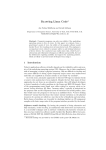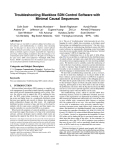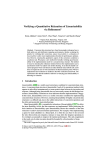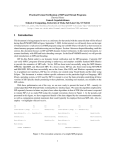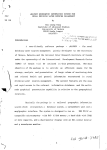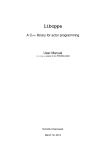Download Test-Driven Development of Concurrent Programs using Concuerror
Transcript
Test-Driven Development of Concurrent
Programs using Concuerror
Alkis Gotovos 1
1
Maria Christakis 1
Konstantinos Sagonas 1,2
School of Electrical and Computer Engineering, National Technical University of Athens, Greece
2
Department of Information Technology, Uppsala University, Sweden
{alkisg,mchrista,kostis}@softlab.ntua.gr
Abstract
This paper advocates the test-driven development of concurrent Erlang programs in order to detect early and eliminate the vast majority of concurrency-related errors that
may occur in their execution. To facilitate this task we have
developed a tool, called Concuerror, that exhaustively explores process interleaving (possibly up to some preemption bound) and presents detailed interleaving information
of any errors that occur. We describe in detail the use
of Concuerror on a non-trivial concurrent Erlang program
that we develop step by step in a test-driven fashion.
Categories and Subject Descriptors D.2.4 [Software
Engineering]: Software/Program Verification; D.2.5 [Software Engineering]: Testing and Debugging
General Terms Reliability, Verification
Keywords
1.
test-driven development, Erlang
Introduction
Erlang is currently gaining popularity mainly due to its
built-in support for concurrency. This support, based on
asynchronous message passing between processes that in
principle do not share any memory, not only differs from
the concurrency support of most other languages, but also
greatly simplifies the development of certain concurrent
programs and makes it significantly less error-prone. Still,
concurrent programming is fundamentally harder than its
sequential counterpart. Its difficulty in avoiding errors and
reasoning about program correctness mainly lies in the
non-determinism that is introduced by unanticipated process interleaving. Often, such interleaving results in subtle concurrency errors which are difficult to reproduce
during testing. Erlang programs are not immune to such
problems. Tools that help programmers detect these errors
early in the development process are needed in Erlang just
as much as in any language.
Permission to make digital or hard copies of all or part of this work for
personal or classroom use is granted without fee provided that copies are
not made or distributed for profit or commercial advantage and that copies
bear this notice and the full citation on the first page. To copy otherwise,
to republish, to post on servers or to redistribute to lists, requires prior
specific permission and/or a fee.
Erlang’11, September 23, 2011, Tokyo, Japan.
Copyright © 2011 ACM 978-1-4503-0859-5/11/09. . . $10.00
[email protected]
To ease the systematic test-driven development of concurrent Erlang programs, we have developed Concuerror
(pronounced /"k6Nk@r@r/, like conqueror), a totally automatic tool that given a set of tests and a program detects
most kinds of concurrency-related runtime errors, namely
process crashes, assertion violations and deadlocks, that
might occur during the execution of these tests.1
The temptation to describe in detail the techniques used
by Concuerror is very strong, but we will try to resist it; a
forthcoming companion paper will deal with this subject.
Instead, the purpose of the current paper is to advocate
test-driven development of concurrent Erlang programs
using small-step iterations and unit tests, while describing
in detail how Concuerror can be used in practice as a
testing and debugging aid. For this purpose, we will write
and test in a loosely test-driven fashion a simple example
program that is a typical use case of concurrent Erlang. We
warn our readers that some of the concurrency errors that
Concuerror will detect may surprise even seasoned Erlang
programmers.
The next section briefly overviews the suitability, or
lack thereof, of existing tools for test-driven development
in Erlang. Section 3 overviews Concuerror’s functionality
and characteristics, followed by Section 4 that presents in
detail the test-driven development of an example program
with the iterative use of Concuerror. The paper ends with
some concluding remarks.
2.
Test-Driven Development in Erlang
Test-driven development [2] is a software development
practice that suggests using a workflow of small threestep iterations, each of them consisting in writing a small
failing test, quickly making it work, and refactoring the
program to remove any code duplication. Although there
exist several testing tools for Erlang, the majority of them
fails to be effective when used for test-driven development
in Erlang’s concurrent setting.
EUnit [3] is the Erlang implementation of the popular
xUnit testing framework and is reportedly the most used
testing tool by Erlang developers [8]. Despite its ease of
use, EUnit executes each test under a single interleaving
and is inadequate for detecting concurrency errors.
1
Concuerror’s code, its manual and further examples can be
found at https://github.com/mariachris/Concuerror.
Quviq’s QuickCheck [1] is a property-based fuzz testing
tool that has been extended with the PULSE scheduler [4]
for randomly interleaving processes to detect concurrency
errors. Besides the random nature of its testing procedure,
that provides no correctness guarantees, the user is required to write properties the program should satisfy using
a special notation. This implies the user’s familiarity with
the non-trivial task of writing properties and, additionally,
excludes the use of existing unit tests.
McErlang [5, 6] is a model checker that utilizes a custom runtime simulator of Erlang’s concurrency semantics to explore program state-space. The ability to deploy
monitors containing linear temporal logic formulas makes
McErlang very powerful in terms of verification capability. Nevertheless, McErlang in its default mode of use employs a very coarse-grained process interleaving semantics. The detection of subtle concurrency errors, similar to
those found in Section 4, might require the manual insertion of unobvious code, a task that is tedious, alters the
original test, and does not concord with the philosophy of
test-driven development.
3.
A Glimpse of Concuerror
As mentioned, Concuerror detects concurrency errors that
may occur when an Erlang function (usually a test) is executed. Existing tests can be readily used in Concuerror
without requiring any modifications of the program under test. By systematically interleaving the participating
processes, Concuerror effectively explores the program’s
state space and detects interleaving sequences with unintended effects, namely abnormal process exits due to an
exception, assertion violations and deadlocks. In Concuerror, any program state where one or more processes are
blocked on a receive statement and no other process is
available for scheduling is considered a deadlock.
Under the hood, Concuerror uses a stateless searching
approach to produce interleaving sequences. Preemption
points, i.e. points in the program where a context-switch is
allowed to happen, are only placed at side-effecting operations, like sends, receives, process exits, etc. Interleaving
redundancy is further reduced by avoiding sequences that
involve process blocks on receive statements. To make
the tool even faster, the user can opt for a heuristic prioritization technique called preemption bounding [7], that
limits the number of produced interleaving sequences according to a user specified parameter.
Concuerror’s operation can be summarized as follows:
The user opens the tool’s graphical user interface (GUI),
imports a number of Erlang modules and chooses a test to
run. As a first step, Concuerror’s instrumenter applies an
automatic parse transformation to the imported modules
in order to insert preemption points into the code. After
the transformed modules have been compiled and loaded,
the tool’s scheduler executes all possible interleaving sequences of the selected test—up to the chosen preemption bound—and reports any errors encountered. If the
user chooses to replay an error, the scheduler executes
the corresponding interleaving sequence and records detailed information about the processes’ actions that is then
displayed in the GUI. Using this information, the user can
iteratively apply code changes and replay the erroneous
interleaving sequence to observe how program execution
is affected. If no errors are reported, a higher preemption bound may be selected for a more thorough exploration, depending on the program’s complexity and the
user’s time constraints. If the test completes without detecting any errors and the preemption bound has not been
reached, the program is indeed free from the kinds of concurrency errors detected by the tool.
Having briefly discussed the characteristics of our tool,
let us now see how Concuerror can be used in practice to
detect subtle concurrency errors.
4.
An Extended Example
4.1
Getting started
We intend to use Concuerror in a test-driven development
process that involves the creation of a generic registration
server, that can, for example, be used to manage limited
system resources. The desired functionality includes starting and stopping the server as well as attaching and detaching processes to it. However, only a limited number of
processes are allowed to be attached to the server at any
moment.
First, we create two Erlang modules, one to contain the
server code (reg_server), the other to contain the tests
(reg_server_tests). Let us start by writing a start/0
function for starting the server and a trivial test that
checks that the function returns ok.
As some EUnit assertion macros can be readily used
in Concuerror tests, we will use one of them, namely
?assertEqual, to check the return value of start/0. This
macro tests two expressions for equality with the convention that the first argument declares the expected value
of the second argument. The reg_server_tests module,
shown in Test 1, uses an include_lib attribute to make
this macro available.
Test Code 1 The initial testing module
-module(reg_server_tests).
-include_lib("eunit/include/eunit.hrl").
start_test() ->
?assertEqual(ok, reg_server:start()).
Our first test uses ?assertEqual to check that start/0
returns ok. Note that functions with a "_test" suffix in
their name are auto-exported by EUnit, thus no export
attribute is needed. The first version of the server module
is shown in Program 1. The module exports the start/0
function, that just returns ok.
Program 1 The initial registration server module
-module(reg_server).
-export([start/0]).
start() ->
ok.
It is time to run our test using Concuerror. The Concuerror GUI is composed of several panels; see Figure 1.
The Modules panel on the upper left side displays a list of
Figure 1. Running a test that passes in Concuerror’s GUI
all Erlang modules imported to Concuerror. These modules
will be instrumented when Concuerror begins its analysis.
The Functions panel on the lower left side displays a list of
all exported functions defined in the module selected from
the Modules panel. The Log panel on the lower right side
displays information about Concuerror actions. Additionally, by selecting the Source tab next to Main, we can see
the source code of the selected module.
Let us run our test before explaining the rest of the
GUI functionality. To import our modules, we either click
the Add button or select File→Add. Through the browse
dialog, we locate our two modules in the file system, select them, and click Open. Our modules have now been
imported and added to the Modules panel. By selecting
module reg_server_tests from this panel, testing function start_test/0 appears in the Functions panel. For
the time being, we will disable preemption bounding by
unchecking the Enable preemption bounding option under
Edit→Preferences. We can now select the test function and
click Analyze to execute the test under Concuerror. The
Log panel informs us about the successful instrumentation
and compilation of our modules as well as about the complete execution of one interleaving sequence without any
errors (see Figure 1).
Let us now change the return value of start/0 from ok
to error and run the analysis again. This time an error appears in the Errors panel, namely an assertion violation on
line 6 of our testing module. Furthermore, in the Process
interleaving panel we can see the erroneous interleaving
sequence. It consists solely of our testing process’ abnormal exit (see Figure 2). We can also select the Problems tab
next to Log to switch to the panel that displays additional
information about the specific error: The expected value
was ok but the call to start/0 returned error. We change
the return value back to ok before proceeding.
These are the basics about importing modules and running tests using the Concuerror GUI. In the next section
we begin implementing the server’s functionality.
4.2
Starting and stopping the server: The basics
We will create a server process and register it under the
name reg_server. To test that the server is spawned and
Figure 2. Information about an erroneous interleaving
Test Code 2 Add a ping test
-module(reg_server_tests).
-include_lib("eunit/include/eunit.hrl").
start_test() ->
?assertEqual(ok, reg_server:start()).
ping_test() ->
reg_server:start(),
?assertEqual(pong, reg_server:ping()),
?assertEqual(pong, reg_server:ping()).
registered as expected, we will create an auxiliary ping/0
function that returns pong if the server responds. In case
the server is down, the ping function should probably
timeout after a while, but we leave this task for later.
We also leave for later the case of start/0 being called
more than once—by either one or more processes. At this
point, we want to spawn the server process, register it
and make it respond to a ping call. To this end we create
ping_test/0, shown in Test 2. We call ping/0 twice to
make sure that the server loop is correct.
To make the test pass, we spawn a new process to start
the server, register it under the name reg_server, and
make it execute function loop/0, as shown in Program 2.
Inside its loop, the server receives ping requests and
replies with pong messages. Function ping/0 sends a ping
request to the server and waits for a pong response. The
macros REG_REQUEST and REG_REPLY are used to avoid confusion with messages sent by other processes.
Running our tests in Concuerror results in both of them
reporting a deadlock. We should be expecting this, because
the server runs in a loop and is blocked waiting for a request, even after the client process, i.e. the process running the test function, has exited. Note that Concuerror
reports a “deadlock”, because the only process alive is
blocked on a receive statement. To avoid the aforementioned behavior, we have to implement the functionality
of stopping the server and use it at the end of our tests.
Again, we leave the handling of multiple stop calls for later.
Program 2 Add spawn, register and ping to the server
Test Code 3 Stop the server at the end of our tests
-module(reg_server).
start_stop_test() ->
?assertEqual(ok, reg_server:start()),
?assertEqual(ok, reg_server:stop()).
-export([ping/0, start/0]).
-define(REG_NAME, reg_server).
-define(REG_REQUEST, reg_request).
-define(REG_REPLY, reg_reply).
start() ->
Pid = spawn(fun() -> loop() end),
register(?REG_NAME, Pid),
ok.
ping_test() ->
reg_server:start(),
?assertEqual(pong, reg_server:ping()),
?assertEqual(pong, reg_server:ping()),
reg_server:stop().
Program 4 The refactored code of Program 3
ping() ->
?REG_NAME ! {?REG_REQUEST, self(), ping},
receive
{?REG_REPLY, Reply} -> Reply
end.
stop() ->
request(stop).
loop() ->
receive
{?REG_REQUEST, Target, ping} ->
Target ! {?REG_REPLY, pong},
loop() ->
receive
{?REG_REQUEST, Target, ping} ->
reply(Target, pong),
loop();
{?REG_REQUEST, Target, stop} ->
reply(Target, ok)
end.
loop()
end.
Program 3 Add stop/0 to the server
-module(reg_server).
-export([ping/0, start/0, stop/0]).
...
stop() ->
?REG_NAME ! {?REG_REQUEST, self(), stop},
receive
{?REG_REPLY, Reply} -> Reply
end.
loop() ->
receive
{?REG_REQUEST, Target, ping} ->
Target ! {?REG_REPLY, pong},
loop();
{?REG_REQUEST, Target, stop} ->
Target ! {?REG_REPLY, ok}
end.
ping() ->
request(ping).
request(Request) ->
?REG_NAME ! {?REG_REQUEST, self(), Request},
receive
{?REG_REPLY, Reply} -> Reply
end.
reply(Target, Reply) ->
Target ! {?REG_REPLY, Reply}.
Test Code 4 Test for two stop calls by one process
multiple_stops_test() ->
reg_server:start(),
?assertEqual(ok, reg_server:stop()),
?assertEqual(server_down, reg_server:stop()).
so at this point we are able to perform the basic operations
of starting, pinging and stopping our server.
4.3
Function stop/0 will be used to stop the server as
shown in the modified tests of Test 3; its implementation
is shown in Program 3. Similarly to ping/0, a message is
sent to the server and the latter replies with ok. However,
in this case, the server terminates instead of looping again.
Now both tests pass when run in Concuerror. Note that
even these small tests produce more than one interleaving
sequence—three in this case—due to the different exit
orders of the two testing processes. Before we continue,
let us refactor the code of Program 3 to remove some of
the duplication that was introduced during our last step.
In Program 4, we define functions request/1 and reply/2
to handle the sending and receiving of messages between
client and server. The tests still pass after the refactoring,
Starting and stopping the server: Advanced
issues
Let us now handle the case of multiple stop calls. We will
first test the case of two consecutive stop calls by one process and then that of two concurrent stop calls by two processes. As shown in Test 4, when a process calls stop/0
and the server is not running, the return value should be
server_down. Running this test in Concuerror results in
three erroneous interleaving sequences, two due to an exception and one due to a deadlock. Looking at the Process
interleaving panel, we notice that the first exception happens when the client process attempts to send a message
to the already exited server process using its registered
name. To fix this error, we can use the whereis/1 builtin to check whether the server name is registered, that
is, whether the server is running, before sending the stop
Program 5 Use whereis/1 before sending a message to
the server
Program 6 Manual insertion of preemption points to detect the problem in McErlang
request(Request) ->
case whereis(?REG_NAME) of
undefined -> server_down;
_Pid ->
?REG_NAME ! {?REG_REQUEST, self(), Request},
receive
{?REG_REPLY, Reply} -> Reply
end
end.
request(Request) ->
Whereis = whereis(?REG_NAME),
mce_erl:pause(
fun() ->
case Whereis of
undefined -> server_down;
_Pid ->
?REG_NAME ! {?REG_REQUEST, self(), Request},
receive
{?REG_REPLY, Reply} -> Reply
end
end
end).
message. In fact, we can do this inside request/1, so that
the check is performed before any message is sent to the
server, as shown in Program 5.
Running the test again, we see that the first error is
fixed but the other two are still there. Now is a good
point to try running the tests using EUnit rather than Concuerror. This can be done by first compiling the modules
and then calling eunit:test(reg_server_tests). EUnit
reports that all three tests pass. We can try it again and
again; the result is the same. The reason is that the errors displayed in Concuerror are caused by interleaving
sequences that are very unlikely to happen in practice.
The interleaving scenarios that are responsible for these
errors are almost impossible to reveal with traditional testing tools, like EUnit; yet, it is still possible that they actually occur.
Back to Concuerror and in the Process interleaving
panel, we can see that both errors have the same cause:
Between the server’s reply and its actual exit, the client
process manages to call whereis/1—it even manages to
send its second stop request in one of the two interleaving
sequences. Because the server has not exited yet, the call
to whereis/1 does not return undefined. Subsequently,
the server exits and, as a result, the client either fails with
an exception, in case it tries to send a stop request to a
process that is not registered anymore, or blocks, in case
it has already sent the request and is waiting for an answer from the non-existing server. The detailed sequence
for the second case, as viewed in the Concuerror GUI, is
shown in Figure 3.
Before fixing the problem, let us run our last test
in McErlang using its default configuration. Like EUnit,
McErlang reports no errors. The reason is that McErlang
in its default mode of use only preempts processes at
receive expressions, although we have just seen that additional preemption points are needed to reveal the particular defect. There are three ways to detect the problem in
McErlang.
The first is to manually insert preemption points using the mce_erl:pause/1 call provided by the tool. In
Program 6 we have used Concuerror’s details about the
problem to insert just enough preemption points for McErlang to also detect it. Manually inserting preemption
points is clearly a tedious task, even when their locations
are priorly known, which is typically not the case when
ignorant about the possibility of concurrency errors at
particular program points. Moreover, the need for alterations in the original program makes the tool less usable
and code maintenance more difficult.
reply(Target, Reply) ->
Target ! ?REG_REPLY, Reply,
mce_erl:pause(fun() -> ok end).
The second way also involves modifying the program
so that every process is spawned on a separate node.
This approach not only alters the existing code, but also
changes its intended semantics. In theory, McErlang also
provides an experimental option for executing the test
under a simulated distributed semantics without the need
for code modifications. However, in practice, enabling this
option does not reveal the defect.
The third way is to activate McErlang’s sends_are_sefs
option, which causes some actions, like sends, links and
monitors, to be considered side-effects, thus enabling a
finer-grained interleaving semantics. This method is by far
the most convenient, yet it is still experimental according
to McErlang’s user manual at the time of this writing.
Returning to the problem of the client calling whereis/1
between the server’s reply and exit, a possible fix is to
have the server unregister itself before replying to a stop
request. The corrected code, that makes all three of our
tests pass in Concuerror, is shown in Program 7.
Program 7 Unregister the server before replying to a stop
request
loop() ->
receive
{?REG_REQUEST, Target, ping} ->
reply(Target, pong),
loop();
{?REG_REQUEST, Target, stop} ->
unregister(?REG_NAME),
reply(Target, ok)
end.
Next, we have to test the case where multiple processes
attempt to stop the server concurrently. We will test this
scenario by spawning two processes, making them stop
the server, and collecting the return values of their stop/0
calls. We expect that one call will return ok and the other
server_down, as shown in Test 5.
Running this test in Concuerror results in a large number of erroneous interleaving sequences. Looking at the
first of them, we notice that both processes call whereis/1
before the server stops. The problem is similar to the one
we had in our previous step. If the server has exited before
Figure 3. Concuerror’s detailed interleaving information helps understand and fix the error
Test Code 5 Test for two concurrent stop calls by two
processes
Program 8 Monitor the server to deal with multiple concurrent stop calls
multiple_concurrent_stops_test() ->
Self = self(),
reg_server:start(),
spawn(fun() -> Self ! reg_server:stop() end),
spawn(fun() -> Self ! reg_server:stop() end),
?assertEqual(lists:sort([ok, server_down]),
lists:sort(receive_two())).
request(Request) ->
case whereis(?REG_NAME) of
undefined -> server_down;
Pid ->
Ref = monitor(process, Pid),
Pid ! {?REG_REQUEST, self(), Request},
receive
{?REG_REPLY, Reply} ->
demonitor(Ref, [flush]),
Reply;
{’DOWN’, Ref, process, Pid, _Reason} ->
server_down
end
end.
receive_two() ->
receive
Result1 ->
receive
Result2 -> [Result1, Result2]
end
end.
the process sends its request, the requesting process will
fail with an exception. Alternatively, if the server exits after the request has been sent, the requesting process will
block waiting for a server reply that will never come.
We have to provide a way for a process to be informed
of whether the server has been stopped by another process
after the execution of its whereis/1 call. To avoid the exceptions, instead of the server’s registered name, we can
use its process identifier (pid) returned by whereis/1 in
request/1. Doing this will result in the transformation of
the exception errors into deadlocks due to processes blocking on the receive expression of request/1. We avoid
these deadlocks by monitoring the server process through
a monitor/2 call just before the request message is sent.
If the server has already exited or exits after the monitoring call, the client process will receive a ’DOWN’ message
from the Erlang runtime and can return server_down. Otherwise, the process will receive a normal reply from the
server. In any case, a message will be received and, therefore, the process will never block. The changes made in the
server code are shown in Program 8. A call to demonitor/2
with the flush option is used to stop monitoring the server
and discard the ’DOWN’ message in case the server has already exited.
Test Code 6 Test calling ping/0 when the server is not
running
ping_failure_test() ->
?assertEqual(server_down, reg_server:ping()),
reg_server:start(),
reg_server:stop(),
?assertEqual(server_down, reg_server:ping()).
ping_concurrent_failure_test() ->
reg_server:start(),
spawn(fun() ->
R = reg_server:ping(),
Results = [pong, server_down],
?assertEqual(true, lists:member(R, Results))
end),
reg_server:stop().
After making the above changes, all tests pass. Note
that our last test produces a large number of interleaving
sequences (more than 800,000) and takes several minutes
to complete. At this point, we can turn on preemption
bounding by selecting the Enable preemption bounding
option under Edit→Preferences and use the default value
of two for the preemption bound. Running the test again,
a considerably lower number of interleaving sequences
(about 1,700) is produced in a matter of seconds.
However, we would also like to know if the previous
defect would have been detected if a preemption bound
of two were used. Temporarily reverting the changes of
Program 8 and running the test again, we can see that
the defect is indeed detected. In fact, the defect is even
detected with a preemption bound of zero. This suggests
that a low preemption bound may often be enough to
reveal many common concurrency errors.
Our next task is dealing with the case of pinging the
server when it is not running. The current version of
request/1 should readily handle this case without the
need for a timeout. To check this, we employ the tests
shown in Test 6. The first test checks that a call to ping/0
returns server_down before starting the server for the first
time as well as after starting and stopping the server. The
second test checks that when a process attempts to ping
the server while another process is trying to stop it, the
ping/0 call will return either pong or server_down. Both
tests pass successfully and we proceed to our next task,
namely dealing with multiple calls to start/0.
Like we did with multiple stop calls, we will test multiple start calls by first using one process and then two.
A call to start/0 should return already_started in case
the server is already running. The corresponding single
process test is shown in Test 7. To make this test work,
we call whereis/1 in start/0 before starting the server. If
whereis/1 returns undefined, the server is spawned and
registered as before, otherwise the server is already running, so already_started is returned. The newly added
server code is shown in Program 9. The test passes with
the new version of start/0 and we are ready to write the
two-process variant.
The test for two concurrent start/0 calls is shown in
Test 8 and is similar to the one we used in Test 5 to test for
two concurrent stop/0 calls. Two processes are spawned
and concurrently attempt to start the server. One of them
Test Code 7 Test for two start calls by one process
multiple_starts_test() ->
reg_server:start(),
?assertEqual(already_started, reg_server:start()),
reg_server:stop().
Program 9 Check if the server is already running before
starting it
start() ->
case whereis(?REG_NAME) of
undefined ->
Pid = spawn(fun() -> loop() end),
register(?REG_NAME, Pid),
ok;
_Pid -> already_started
end.
Test Code 8 Test for two concurrent start calls by two
processes
multiple_concurrent_starts_test() ->
Self = self(),
spawn(fun() -> Self ! reg_server:start() end),
spawn(fun() -> Self ! reg_server:start() end),
?assertEqual(lists:sort([already_started, ok]),
lists:sort(receive_two())),
reg_server:stop().
should observe a return value of ok and the other a return
value of already_started. The new test fails when run
in Concuerror. As seen from the detailed interleaving information, when the two processes call whereis/1 before
the server is started, they both try to spawn and register
the server and one of them fails with an exception. Ideally, we would like the block of code containing whereis,
spawn and register to be executed atomically, but this is
currently not possible in Erlang.
Instead, we may use the solution of allowing multiple
processes to be spawned, but only one of them to be properly registered as the server process. Subsequently, processes that fail to be registered have to be killed. To accomplish the above, we use a try...catch expression around
the register/2 call and send a message to the spurious
process, forcing it to exit, as shown in Program 10. Note
that we cannot use a call to request/1 to kill such a process, because it has not been registered.
Our last test produces a large number of interleaving
sequences, thus it is preferable to start with a small preemption bound and gradually increase it while finding and
correcting any errors encountered. At this point, all of
our tests pass with or without preemption bounding, so
we have successfully completed the implementation of the
functions for starting and stopping our server.
4.4
Attaching processes
Any process should be able to become attached to our
server. A unique integer, that for our purposes will be
called a registration number, is assigned to each attached
process. The server only allows for a limited number of
attached processes. We will define the maximum number
Program 10 Use try...catch to avoid spurious server
processes
start() ->
case whereis(?REG_NAME) of
undefined ->
Pid = spawn(fun() -> loop() end),
try register(?REG_NAME, Pid) of
true -> ok
catch
error:badarg ->
Pid ! {?REG_REQUEST, kill},
already_started
end;
_Pid -> already_started
end.
...
loop() ->
receive
{?REG_REQUEST, Target, ping} ->
reply(Target, pong),
loop();
{?REG_REQUEST, Target, stop} ->
unregister(?REG_NAME),
reply(Target, ok);
{?REG_REQUEST, kill} -> killed
end.
Test Code 9 Test for attaching two processes to the server
attach_test() ->
Self = self(),
reg_server:start(),
RegNum1 = reg_server:attach(),
spawn(fun() ->
RegNum2 = reg_server:attach(),
?assertEqual(RegNum2, reg_server:ping()),
?assertEqual(false, RegNum1 =:= RegNum2),
Self ! done
end),
?assertEqual(RegNum1, reg_server:ping()),
receive done -> reg_server:stop() end.
of attached processes in the MAX_ATTACHED macro of an
external reg_server.hrl file, so that it can be included in
both the server code and the tests.
To be able to check if a process is attached, we will
extend the ping/0 function to return the calling process’
registration number in case it is attached to the server. The
attachment of two processes can be checked using the test
of Test 9. We use attach/0 to attach the calling processes
to the server. Function attach/0 returns the registration
number that was assigned to the calling process. The test
also checks that the two processes are not given equal
registration numbers. What happens when a process calls
attach/0 while it is already attached or when the maximum number of attached processes has been reached?
Should a process become detached when it exits? All these
matters will be handled later.
For now, let us try to make our last test pass. The server
can use an ordered set to keep track of the free registration numbers. Initially, this set will contain the numbers from 1 to MAX_ATTACHED. Additionally, the server can
Program 11 Add attach/0 to the server
-module(reg_server).
-export([attach/0, ping/0, start/0, stop/0]).
-include("reg_server.hrl").
...
-record(state, {free, reg}).
attach() ->
request(attach).
start() ->
case whereis(?REG_NAME) of
undefined ->
Pid = spawn(fun() -> loop(initState()) end),
...
end.
initState() ->
FreeList = lists:seq(1, ?MAX_ATTACHED),
#state{free = ordsets:from_list(FreeList),
reg = dict:new()}.
...
loop(#state{free = Free, reg = Reg} = State) ->
receive
{?REG_REQUEST, Target, attach} ->
[RegNum|NewFreeList] = ordsets:to_list(Free),
NewReg = dict:store(Target, RegNum, Reg),
reply(Target, RegNum),
NewFree = ordsets:from_list(NewFreeList),
NewState = State#state{free = NewFree,
reg = NewReg},
loop(NewState);
{?REG_REQUEST, Target, ping} ->
case dict:find(Target, Reg) of
{ok, RegNum} -> reply(Target, RegNum);
error -> reply(Target, pong)
end,
loop(State);
...
end.
use a dictionary to store mappings from registered processes’ pids to their corresponding registration numbers.
Both structures can be packed into a record that will represent the state of the server and will be passed as an argument to its loop. Other than that, the request-reply infrastructure that we have created so far can also be used
here, in order to automatically handle the case of calling
attach/0 when the server is down. The implementation of
all of the above is shown in Program 11.
Every time a process requests to become attached, the
server removes a free registration number from its set and
adds a ’pid to registration number’ mapping to the dictionary. Note that the header file reg_server.hrl contains
only the attribute -define(MAX_ATTACHED, 2). (A small
number is used here to simplify our testing.) We do not
need to import this header file in Concuerror; it is automatically recognized since it resides in the same directory
Test Code 10 Test for already attached processes and full
server
Program 12 Extend server to deal with already registered
processes and full server
-module(reg_server_tests).
loop(#state{free = Free, reg = Reg} = State) ->
receive
{?REG_REQUEST, Target, attach} ->
case dict:find(Target, Reg) of
{ok, RegNum} ->
reply(Target, RegNum),
loop(State);
error ->
case ordsets:to_list(Free) of
[] ->
reply(Target, server_full),
loop(State);
[RegNum|NewFreeList] ->
NewReg = dict:store(Target, RegNum, Reg),
reply(Target, RegNum),
NewFree = ordsets:from_list(NewFreeList),
NewState = State#state{free = NewFree,
reg = NewReg},
loop(NewState)
end
end;
...
end.
-include_lib("eunit/include/eunit.hrl").
-include("reg_server.hrl").
already_attached_test() ->
reg_server:start(),
RegNum = reg_server:attach(),
?assertEqual(RegNum, reg_server:attach()),
reg_server:stop().
max_attached_proc_test() ->
reg_server:start(),
L = lists:seq(1, ?MAX_ATTACHED),
Ps = [spawn_attach() || _ <- L],
?assertEqual(server_full, reg_server:attach()),
lists:foreach(fun(Pid) -> Pid ! ok end, Ps),
reg_server:stop().
attach_and_wait(Target) ->
reg_server:attach(),
Target ! done,
receive ok -> ok end.
spawn_attach() ->
Self = self(),
Pid = spawn(fun() -> attach_and_wait(Self) end),
receive done -> Pid end.
as the .erl files. With the above additions the test passes
successfully.
We will work on our next two tasks in one step because
they are fairly simple. The first is to handle an attach/0
call from an already attached process. The server can either ignore the call and return the already allocated registration number or, alternatively, return a special value indicating an error. We will choose the first option here and
check it with the first test shown in Test 10. The second
task is to handle the case of a process requesting to become attached when the server is already full of attached
processes, as determined by MAX_ATTACHED. In this case
we would like the attach/0 call to return server_full, as
shown in the second test of Test 10.
For the tests to pass, before attaching the requesting
process, we need to check whether it already has a registration number and, if not, whether there are any free
registration numbers. This is easily done inside the server
loop, as shown in Program 12.
Our new tests pass successfully in Concuerror. The
second test produces 822 interleaving sequences for a
preemption bound of two. The current execution of our
test contains a total of four processes—the initial process,
the server process and two additional spawned processes.
Let us change the value of MAX_ATTACHED to one, so that
our test contains three processes. Leaving the preemption bound at two, there are now only 65 interleaving sequences produced. Trying the same with MAX_ATTACHED
equal to three and four, 9,789 and 118,038 interleaving sequences are produced, respectively. This clearly indicates
that the number of interleaving sequences grows exponentially as the number of testing processes increases.
Test Code 11 Test for detaching
detach_test() ->
reg_server:start(),
reg_server:attach(),
reg_server:detach(),
?assertEqual(pong, reg_server:ping()),
reg_server:stop().
Test Code 12 Test for reattaching after detaching
detach_attach_test() ->
Self = self(),
reg_server:start(),
L = lists:seq(1, ?MAX_ATTACHED - 1),
Ps = [spawn_attach() || _ <- L],
LastProc = spawn(fun() ->
RegNum = reg_server:attach(),
reg_server:detach(),
Self ! RegNum,
receive ok -> ok end
end),
receive RegNum -> ok end,
?assertEqual(RegNum, reg_server:attach()),
lists:foreach(fun(Pid) -> Pid ! ok end, [LastProc|Ps]),
reg_server:stop().
4.5
Detaching processes
We have finished our tasks concerning the attachment of
processes and now proceed to handling their detachment
from the server. When a process is detached from the
server using a detach/0 call, it should no longer have an
assigned registration number, thus a ping/0 call to the
server after the process’ detachment should return pong.
This is checked by the test in Test 11. Moreover, the server
should make the corresponding registration number available to future processes requesting attachment. To check
Program 13 Add detach/0 to the server
-module(reg_server).
-export([attach/0, detach/0, ping/0, start/0, stop/0]).
...
detach() ->
request(detach).
...
loop(#state{free = Free, reg = Reg} = State) ->
receive
{?REG_REQUEST, Target, detach} ->
RegNum = dict:fetch(Target, Reg),
NewReg = dict:erase(Target, Reg),
NewFree = ordsets:add_element(RegNum, Free),
reply(Target, ok),
NewState = State#state{free = NewFree,
reg = NewReg},
loop(NewState);
...
end.
Test Code 13 Test for trying to detach an unattached
process
detach_non_attached_test() ->
reg_server:start(),
?assertEqual(ok, reg_server:detach()),
reg_server:stop().
this, we can extend the second test of Test 10 so that when
one of the processes is detached, another process becomes
attached with the same registration number, which is the
only one available at the time, as shown in Test 12. To
make the tests pass, the server needs to remove the existing mapping from the dictionary and add the freed registration number back to the set, as shown in Program 13.
After having successfully run our last tests and before
proceeding to our final task, we have to deal with one
more issue, namely handling the case of a process calling detach/0 without being attached. Similarly to the case
of the double attach/0 call that we encountered previously, we can either ignore this case and return ok or consider it an error. Again, we opt for the silent approach, as
shown in Test 13. The fix is fairly simple and is shown in
Program 14.
Currently, an attached process is detached only when it
calls detach/0. If an attached process exits without having been detached on its own, its registration number will
remain occupied forever. Consequently, our last task is to
enforce detaching a process as soon as it exits. To check
this, we modify the test in Test 11 so that the last process
being spawned, instead of explicitly detaching itself, simply terminates its execution. The main testing process tries
to attach itself after receiving the ’EXIT’ message from
this previously attached process. For the ’EXIT’ message
to be received, a process_flag/2 call is used to activate
the trap_exit flag of the main process. The test is shown
in Test 14.
Program 14 Deal with trying to detach an unattached
process
loop(#state{free = Free, reg = Reg} = State) ->
receive
{?REG_REQUEST, Target, detach} ->
case dict:is_key(Target, Reg) of
false ->
reply(Target, ok),
loop(State);
true ->
RegNum = dict:fetch(Target, Reg),
...
loop(NewState)
end;
...
end.
Test Code 14 Test for detaching a process as soon as it
exits
detach_on_exit_test() ->
Self = self(),
reg_server:start(),
L = lists:seq(1, ?MAX_ATTACHED - 1),
Ps = [spawn_attach() || _ <- L],
process_flag(trap_exit, true),
LastProc = spawn_link(fun() ->
Self ! reg_server:attach()
end),
receive RegNum -> ok end,
receive {’EXIT’, LastProc, normal} -> ok end,
?assertEqual(RegNum, reg_server:attach()),
lists:foreach(fun(Pid) -> Pid ! ok end, [LastProc|Ps]),
reg_server:stop().
The server needs to know when a process exits in order
to take action and detach it. This means that we have
to use either links or monitors to keep track of attached
processes. There is no reason to use two-sided links here,
thus we will have the server create a monitor for every
process that becomes attached. Also, as soon as the server
receives a ’DOWN’ message about an attached process, that
process will be detached. In Program 15 we implement the
above functionality and move the detachment operation
into a separate function to avoid code duplication.
At this point, our final test passes successfully in Concuerror, as do all of our previous tests. We do not claim
that our code is entirely free of bugs. However, the tests
that we have written check the basic functionality of our
server and make us confident that any scenario that may
occur in practice and has been covered by our tests will
actually work as expected.
5.
Concluding Remarks
Summing up, we would like to stress some important
points that came up during the presentation of our development process. First, we quickly realized that conventional testing using EUnit was not able to expose the
concurrency errors we encountered, whereas trying to test
with the current version of McErlang presented some serious usability issues. Given that our server was destined
to be used in a highly concurrent environment, Concuerror not only allowed us to verify that our tests pass under
Program 15 Detach a process as soon as it exits
References
loop(#state{free = Free, reg = Reg} = State) ->
receive
{?REG_REQUEST, Target, attach} ->
...
[RegNum|NewFreeList] ->
NewReg = dict:store(Target, RegNum, Reg),
monitor(process, Target),
reply(Target, RegNum),
...
{?REG_REQUEST, Target, detach} ->
{Reply, NewFree, NewReg} =
detach_proc(Target, Free, Reg),
reply(Target, Reply),
NewState = State#state{free = NewFree,
reg = NewReg},
loop(NewState);
{’DOWN’, _Ref, process, Target, _Info} ->
NewState =
case dict:is_key(Target, Reg) of
true ->
{ok, NewFree, NewReg} =
detach_proc(Target, Free, Reg),
State#state{free = NewFree,
reg = NewReg};
false -> State
end,
loop(NewState)
end.
[1] T. Arts, J. Hughes, J. Johansson, and U. Wiger. Testing telecoms
software with Quviq QuickCheck. In Proceedings of the 2006
ACM SIGPLAN Workshop on Erlang, pages 2–10, New York,
NY, USA, 2006. ACM.
detach_proc(Target, Free, Reg) ->
case dict:is_key(Target, Reg) of
false -> {ok, Free, Reg};
true ->
RegNum = dict:fetch(Target, Reg),
NewReg = dict:erase(Target, Reg),
NewFree = ordsets:add_element(RegNum, Free),
{ok, NewFree, NewReg}
end.
some random interleaving, but we were guaranteed that
under any interleaving our program was still robust and
correct with respect to our test suite. Second, for all of our
tests, a preemption bound of two was enough to uncover
any concurrency-related defect. It is usually convenient to
start with a low preemption bound and gradually increase
it for more thorough testing. Third, we observed the exponential increase in the number of interleaving sequences
with respect to the number of processes. This suggests
writing our tests to use only a few processes and then
generalizing their results for an arbitrary number of them.
Last, but not least, besides revealing errors, Concuerror
also helped us understand their cause by displaying detailed interleaving information. (This is better experienced
by actually running Concuerror through the example of
this paper.) By walking through the erroneous interleaving
sequences, we could quickly understand and correct the
source of each defect.
The complete code of our example can be found at
https://github.com/mariachris/Concuerror under the
resources/tdd directory.
[2] K. Beck. Test-Driven Development: By Example. AddisonWesley Longman Publishing Co., Inc., Boston, MA, USA, 2002.
[3] R. Carlsson and M. Rémond. EUnit: A lightweight unit testing
framework for Erlang. In Proceedings of the 2006 ACM SIGPLAN Workshop on Erlang, pages 1–1, New York, NY, USA,
2006. ACM.
[4] K. Claessen, M. Pałka, N. Smallbone, J. Hughes, H. Svensson,
T. Arts, and U. Wiger. Finding race conditions in Erlang with
QuickCheck and PULSE. In Proceedings of the 14th ACM SIGPLAN International Conference on Functional Programming,
pages 149–160, New York, NY, USA, 2009. ACM.
[5] C. B. Earle and L.-Å. Fredlund. Recent improvements to the
McErlang model checker. In Proceedings of the 8th ACM
SIGPLAN Workshop on Erlang, pages 93–100, New York, NY,
USA, 2009. ACM.
[6] L.-Å. Fredlund and H. Svensson. McErlang: A model checker
for a distributed functional programming language. In Proceedings of the 12th ACM SIGPLAN International Conference
on Functional Programming, pages 125–136, New York, NY,
USA, 2007. ACM.
[7] M. Musuvathi and S. Qadeer. Iterative context bounding for
systematic testing of multithreaded programs. In Proceedings
of the 2007 ACM SIGPLAN Conference on Programming Language Design and Implementation, pages 446–455, New York,
NY, USA, 2007. ACM.
[8] T. Nagy and A. Nagyné Víg. Erlang testing and tools survey.
In Proceedings of the 7th ACM SIGPLAN Workshop on Erlang,
pages 21–28, New York, NY, USA, 2008. ACM.











